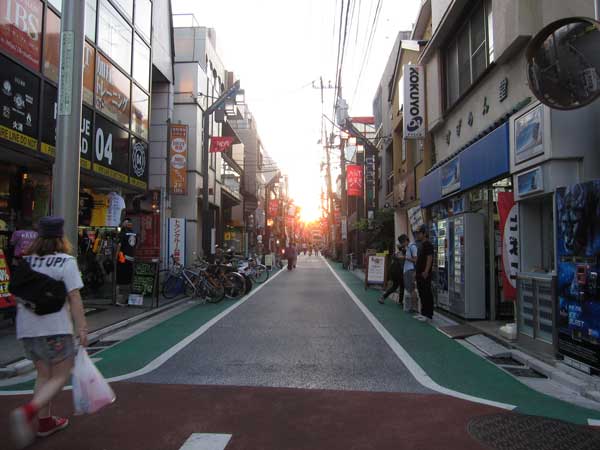
shoutengai
Lush second floor garden on Shin Koenji shopping street

高円寺ルックという商店街の、フランス風の家庭用品の店は二階に庭を作っています。植木鉢は長くて深いので、植物の種類は多いです。このきれいな庭は、すでにあるものをさらに良く見せています。この商店街は古いものと新しいものを組み合わせることに成功しています。
On my favorite Koenji shopping street called “Look,” a shop selling feminine French homewares just built a lush second floor garden. By attaching two long and deep planters, they have transformed this older building with new life. I love the variety of plants, and the way the garden adds onto what is already there.
The shop is called Malto and they are online, too.


Sunset over Shimokitazawa commercial street

最近、よくこの下北沢の商店街に行きます。日暮れはとてもきれいです。自転車で行けて、おいしいコーヒーのお店があります。東京の商店街には、いろいろ小さな店があります。商店街のデザインは散歩したり、ぶらぶらしたりすることがしやすいようになっています。古いけれど、商店街のストリートデザインはヨーロッパとアメリカで人気が出てきています。どうして都庁は車を支持して、商店街を支持しないのでしょう?
Recently I have been spending more time on this Shimokitazawa shoutengai, or commercial strip full of very small businesses. This one is northwest of the station, and somewhat hard to find. What’s great is its combination of shops run by old timers alongside imported hipster clothes, one of Tokyo’s best coffee shops called Bear Pond that roasts their own beans, a hookah bar, and at least ten hair salons.
There are thousands of these shopping streets in Tokyo, near transit stations and along routes that connect homes, workplaces, schools, and leisure areas. It’s strange that Tokyo Metropolitan Government is still so focused on cars and their movement across the city at the expense of walking and biking and other forms of common space usage. There is little government recognition or support for the idea that these relics of past decades are in fact some of Tokyo’s most forward-looking urban public spaces.
Lively pedestrian zones are common in Europe, and becoming more so in many cities in the United States. By not segregating cars, pedestrians, and bicycles, the street pace slows down to pedestrian speed while still allowing passage for delivery trucks and cars. The way the street is painted makes it appear even more narrow, providing further social cues about speed and usage.
Many of Tokyo’s shoutengai are suffering as consumers shift towards shopping at big box stores and driving as a primary form of transportation. The city government is truly looking backwards when it promotes automobile usage and fails to recognize the value of these vernacular public spaces that support human interaction and the environment.
Edoble brings people together to eat free food growing in Tokyo

Through this blog, I was contacted by Edoble, whose tag line is “free food everywhere, in Tokyo.” Last month Edoble organized a hassaku marmelade party at a small shoutengai in Nakano, not far from where I live.
Edoble’s founder Jess Mantell is a Canadian designer, doctoral student, city explorer, and community organizer. As you can see from the poster above, she’s a great illustrator, too. At Keio University, she previously led a team that created an iPhone app that tracks movement across Tokyo with city sounds.
Edoble’s hassaku marmalade making event was great fun. Hassaku is a citrus tree that I often see growing in older gardens in Tokyo. The tree is very robust, and the fruits bright orange and large starting in winter. Seeing them makes me feel like there’s a bit of Florida or Southern California in Tokyo. But everyone had told me that the fruit is inedible. Jess’ idea was to bring people together to harvest and prepare hassaku.
It seems that if you pick the fruit at different times, the taste changes. Jess spotted mature hassaku trees in an abandoned city middle school near her house in south Nakano. She asked permission from the ward office to harvest the fruit in the spring, and several city workers unlocked the gate and joined her in collecting and sharing the fruit. That alone is pretty cool.
In June, Edoble hosted a marmalade party as a public event at a small space that is shared by the shoutengai association. On June 11, about twenty people very rapidly peeled the fruit, eliminated the membrane, put the seeds and membrane into a cheese cloth, and then boiled everything in four large pots. It was fun to see the amazing knife skills, particularly the older women and one young nursery school chef. We even got some help from some neighborhood kids.
The workshop was super-inspiring. It is great to realize how much food is growing in Tokyo, and that we can join with our neighbors in collecting and preparing super local food. Edoble’s accomplishment was in bringing together residents and local government, children and seniors, mostly Japanese and a few foreigners, mostly women and a few men.
Edoble reminds me that cities can grow a lot more of their own food, and that residents enjoy opportunities to work together and share food. Urban foraging is low cost and high return.



